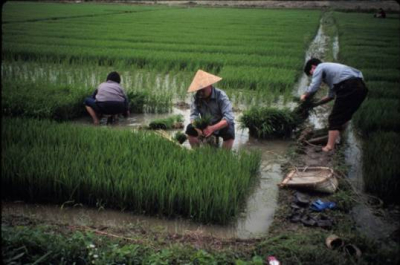
Asian farming maximizes space and time
 Traditional Chinese
agriculture made extremely efficient use of space and time. One
trick they used was to apply heavy inputs of organic fertilizer,
allowing crop plants to be spaced very close together. (More on
the fertilizers tomorrow.)
Traditional Chinese
agriculture made extremely efficient use of space and time. One
trick they used was to apply heavy inputs of organic fertilizer,
allowing crop plants to be spaced very close together. (More on
the fertilizers tomorrow.)
Farmers also used
several techniques to tease two to four crops out of their farm each
year. They started most plants in seed beds so that space in the
main part of the farm was left open for an early season crop. A
typical rotation might include early season beans, followed by a grain
(such as the rice shown here). During the final month of a
grain's growth period, a third crop (like cotton) was often
interplanted so that the cotton could get a few weeks' head start on
the fall season. Those of us who are lax about our fall
gardens should take
heed!
As we all know, animals
require about five times as much land per calorie as vegetables do, so
it should come as no surprise that the traditional Chinese diet is very
low on meat. King noted that the primary meat animal was pigs,
which he explains convert plant matter to meat at the most efficient
rate.
And how about tree
crops? The best example of space-saving orcharding in the book
was the technique Japanese farmers used to raise pear trees. The
branches were trained to grow horizontally along an arbor just high
enough off the ground that farmers could walk underneath and easily
pick the fruit. Trees were spaced just twelve feet apart, and the
dense foliage shaded out most undergrowth. The technique sounds a
lot like espaliered
fruit trees to me.
| This post is part of our Traditional Asian Farming lunchtime series.
Read all of the entries: |
Want more in-depth information? Browse through our books.
Or explore more posts by date or by subject.
About us: Anna Hess and Mark Hamilton spent over a decade living self-sufficiently in the mountains of Virginia before moving north to start over from scratch in the foothills of Ohio. They've experimented with permaculture, no-till gardening, trailersteading, home-based microbusinesses and much more, writing about their adventures in both blogs and books.
Want to be notified when new comments are posted on this page? Click on the RSS button after you add a comment to subscribe to the comment feed, or simply check the box beside "email replies to me" while writing your comment.
